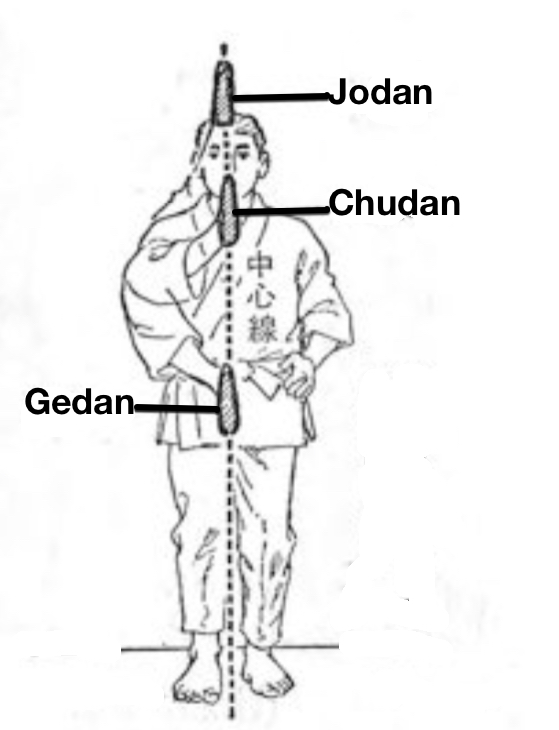It is the Earth which allows to generate force with the legs.
Internal Martial Art
Seichusen

In “Aikido-Tradition and the Competitve Edge” written by Fumiaki Shishida and Tetsuro Nariyama the definition of “Seichusen” is as follows:
The human body displays bilateral symmetry. Seichusen is a vertical line through both the nose and the navel down the center of the body that cuts into two exact halves.
Of course, this definition gives us just a 2D image, whereas our body is a 3D object. The idea of bilateral symmetry is right if you see the body of the front face. On the other hand, another point of view does not follow the bilateral symmetry.
A view from any angle at the seichusen can be seen as the center line which divides the body into 2 halves. These 2 halves are not symmetrical, except for the front or back view.
A column full of power
Seichusen or the centerline always stretches in the direction from top to bottom. This creates a line of strength needed for good posture.
A strong position is not only with the vertical line, but in a horizontal plane as well.

The centerline should be viewed as the midline of a column. This column can be very thin, but can also be very broad and full of power generated using the legs.
The column strength lines are oriented in six directions.
- Up and down
- Forward and backward
- Left and right
A column full of power is embedded in the various postures and positions we can adopt during training.
An example of how Seichusen works.
Testing posture with footwork
Footwork is a basic skill to perform effectively while exercising. Maintaining a strong yet flexible stance is a condition for moving when an adversary is involved.
Mu-gamae & Hanmi

Mu-gamae is mostly translated as empty posture or no-posture. In fact, when you just are in a standing position with parallel feet and your arms at the side of the body, we can consider this as “mu-gamae”. There is no intention in this posture.
There are 2 important control centers
- Kyokotsu – upper center
- Hara tanden – lower center
By moving a foot forward and turning the body, we create a stance mostly named as “hanmi” (half body turn).
If one thinks about Aikido as Budo, then it is necessary that one considers mugamae, right position (hanmi) and left position (hanmi) as 3 in 1. The 3 basic modes have of course an integrated seichusen and the column of power.
“Hanmi is efficient when you step in from mugamae to the opponent or when you want to apply a technique. But as a starting position, hanmi is not very useful.”
Kenji Tomiki
3 types of hanmi
Using hanmi has 3 modes. Each mode is associated with a type of movement expressed by the bodyweight transfer.
- Neutral position, bodyweigth in the middle
- Forward position, bodyweight forward
- Backward position, bodyweight backward
Generating strength with the legs
Essentially, all of our strength comes from our legs. It is initiated from the lower body and then moved by the hara tanden to kyokotsu and distributed to the hands.

When you push with your legs down, there is a rebound, which is guided with your knees in your hips. They must be flexible and do not brake.
The role of the knees is important, these joints move toward each other during a forward motion. With a motion to the back, they separate. Knee motions are measured in millimetres.
Moving forward, the front leg and knee move downward. As you move backwards, your back leg and knee move downwards.
Don’t forget to fold your hips as if sitting on a high stool.
Hara Tanden and kyokotsu
Tanden and kyokotsu are two centres used as a distribution tool for the force generated in the body through the use of the legs. Find more information in a different article about kyokotsu and hara tanden.
Moving with tegatana.
All power generated by the legs has to be transferred to the hand and/or arm. The tool we use to transmit our power to the target is tegatana.
What is Tegatana?
When the 5 fingers are stretched enough, the base of the hand is stretched overflowing into the little finger. In the small sense this is called tegatana, but in a broader context this becomes the forearm (from wrist to elbow). Tegatana exercises include both hand length and arm length exercises
Tegatana no kamae
This is an extension of mugamae and hanmi (hidari/migi no kamae)

3 types of tegatana no kamae
These are chudan (middle level), jodan (upper level) and gedan (lower level), where chudan is used as a basis where the tegatana is kept in the seichusen (centerline) of the body
3 conditions for movement with tegatana
- The use of posture with correct stability.
- Positioning the tegatana in relationship with seichusen or correctly on the center line of the body.
- To ensure that the use of the tegatana corresponds to the foot movement carried out at the same time.
